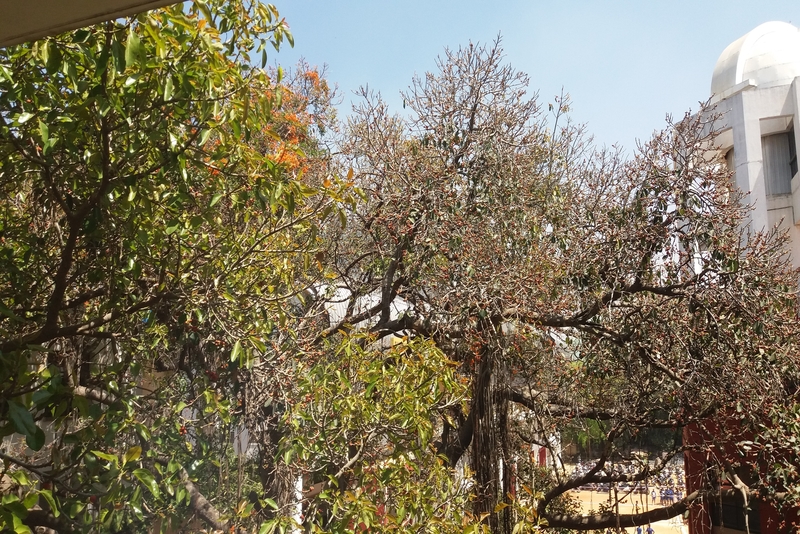Feathered visitors from Europe

Walking away from class this week down the corridor of the third floor after a morning of lectures, a very busy sounding twittering attracted my attention, and my eyes swivelled towards the massive ficus growing in the college compound. To my utter surprise I could see a really large number of birds noisily feasting on the huge amount of ficus fruit growing on the tree.
Checking on the net I read that year after year, flocks of rosy starlings (Pastor roseus) migrate from Eastern Europe across Southern Asia to the south. The bird is definitely a strong migrant flyer, to be able to travel that distance in winter to India. It is a winter visitor in Sri Lanka and India, including the states of Karnataka, Kerala, Tamil Nadu, Telangana and the rest of Andhra.
“Rosy starlings have already arrived in the city in certain locations,” says Joiston Pereira. “These pretty birds are often the harbingers of the yearly migration of birds to our southern shores, wintering here before going back,” shares avid birder Deepa Mohan. “These birds, also called as rosy pastors, are a delightful sight as flocks of them flutter in the air, settling like pinkish leaves, on trees.”
According to Wikipedia, these birds belong to the starling family and the adult of this species is highly distinctive, with its pink body, pale orange legs and bill. It has a glossy black head, wings and tail. Males in the breeding season have foppish head feathers, which form a wispy crest that is fluffed and more prominent when the bird gets excited. In fact, the floppy hair style of some of our male celebrities and models, seem to have been copied off the bird! Their song, says Wiki, is a typical mixture of squeaks and rattles, given with much wing trembling.
“Generally seen in large groups, it is a pleasure to watch the huge flock doing what is known as murmuration. Having migrated in millions to spend their winters here, these birds put up quite a show, especially at dawn and dusk. Researchers and scientists aren’t sure why murmurations happen but they have theories that suggest that this chaotic, yet graceful motion might be to confuse and ward off predators,” says Bopanna Pattada. While Swaroop Bharadwaj says, “Thousands gather and form a bird cloud which looks like a flock of honey bees travelling, from a distance.”
Their numbers are so large and because they move around in flocks, they often appear to outnumber the local starlings and mynas in the city.
Research conducted on these birds in the 80s, in China, found that they primarily feed on flightless locusts. This practice helped in the elimination of locusts in fields where they were the main crop pests, thereby reducing dependence on chemical insecticide which is harmful for humans. By the end of the 20 Century, application of insecticide to the crops was decreased to a great extent, says the study.
Migration of rosy starlings has been going on for centuries and it’s a great feeling to welcome these winter visitors year after year,say Bangalore bird lovers. So if you have a chance, go across to St. Joseph’s College of Arts and Science on Lalbagh Road and enjoy the sight of our feathered friends, feasting away in Lent!
Checking on the net I read that year after year, flocks of rosy starlings (Pastor roseus) migrate from Eastern Europe across Southern Asia to the south. The bird is definitely a strong migrant flyer, to be able to travel that distance in winter to India. It is a winter visitor in Sri Lanka and India, including the states of Karnataka, Kerala, Tamil Nadu, Telangana and the rest of Andhra.
“Rosy starlings have already arrived in the city in certain locations,” says Joiston Pereira. “These pretty birds are often the harbingers of the yearly migration of birds to our southern shores, wintering here before going back,” shares avid birder Deepa Mohan. “These birds, also called as rosy pastors, are a delightful sight as flocks of them flutter in the air, settling like pinkish leaves, on trees.”
According to Wikipedia, these birds belong to the starling family and the adult of this species is highly distinctive, with its pink body, pale orange legs and bill. It has a glossy black head, wings and tail. Males in the breeding season have foppish head feathers, which form a wispy crest that is fluffed and more prominent when the bird gets excited. In fact, the floppy hair style of some of our male celebrities and models, seem to have been copied off the bird! Their song, says Wiki, is a typical mixture of squeaks and rattles, given with much wing trembling.
“Generally seen in large groups, it is a pleasure to watch the huge flock doing what is known as murmuration. Having migrated in millions to spend their winters here, these birds put up quite a show, especially at dawn and dusk. Researchers and scientists aren’t sure why murmurations happen but they have theories that suggest that this chaotic, yet graceful motion might be to confuse and ward off predators,” says Bopanna Pattada. While Swaroop Bharadwaj says, “Thousands gather and form a bird cloud which looks like a flock of honey bees travelling, from a distance.”
Their numbers are so large and because they move around in flocks, they often appear to outnumber the local starlings and mynas in the city.
Research conducted on these birds in the 80s, in China, found that they primarily feed on flightless locusts. This practice helped in the elimination of locusts in fields where they were the main crop pests, thereby reducing dependence on chemical insecticide which is harmful for humans. By the end of the 20 Century, application of insecticide to the crops was decreased to a great extent, says the study.
Migration of rosy starlings has been going on for centuries and it’s a great feeling to welcome these winter visitors year after year,say Bangalore bird lovers. So if you have a chance, go across to St. Joseph’s College of Arts and Science on Lalbagh Road and enjoy the sight of our feathered friends, feasting away in Lent!

Related Articles
Editor's Picks Articles
Top Ten Articles
Previous Features
Site Map
Content copyright © 2023 by Marianne de Nazareth. All rights reserved.
This content was written by Marianne de Nazareth. If you wish to use this content in any manner, you need written permission. Contact Marianne de Nazareth for details.





 -resizeimage.jpg.jpg)

